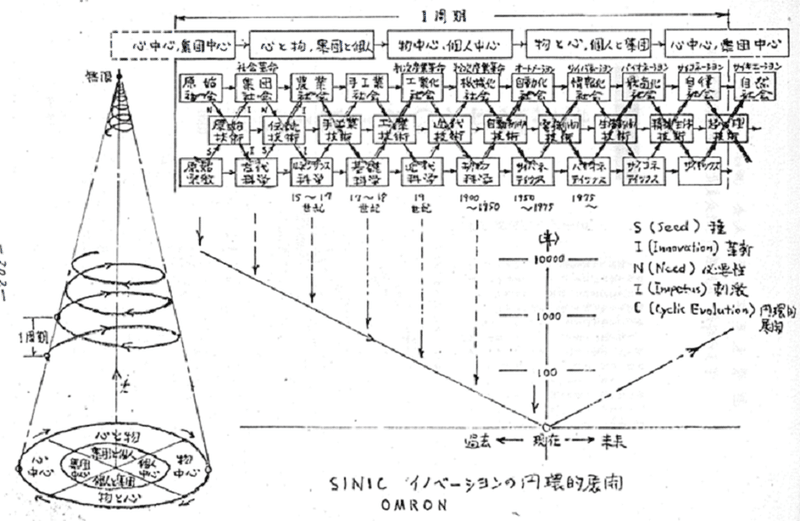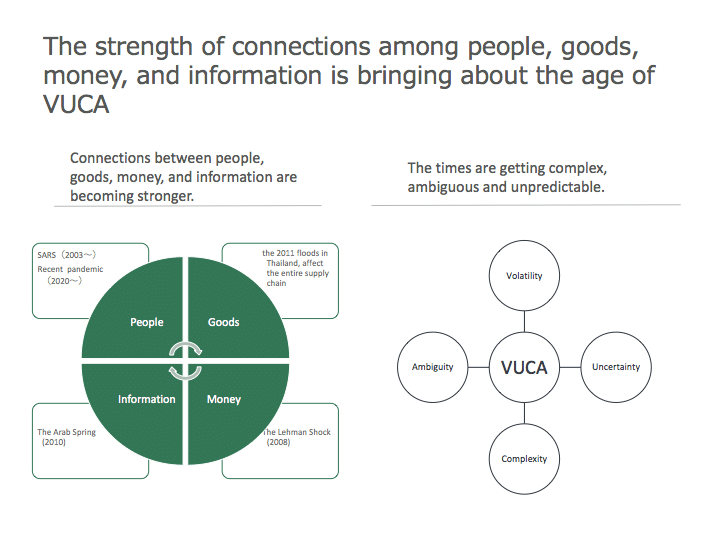
世の中の流れをどのように捉えればいいのか
前回の記事では「チームメンバーとして、既にあるヴィジョンをどう捉えればよいのか?」という問いに対して、チームのヴィジョンを再解釈するというアプローチをご紹介し、「だれでも、どんな立場であってもヴィジョンの設定はできること」についてお話ししました。
今回の記事では、ヴィジョンの構想プロセスにおいて、よくいただく3つ目の質問として「世の中の流れをどのように捉えればいいのか」についてお話します。
ヒト・モノ・カネ・情報のつながりの強さが、VUCAの時代をもたらしている
みなさんは、バタフライ効果という言葉を聞いたことがあるでしょうか。
バタフライ効果
初期条件のわずかな差が、その結果に大きな違いを生むこと。チョウがはねを動かすだけで遠くの気象が変化するという意味の気象学の用語をカオス理論に応用した(大辞林)
そして、このバタフライ効果は、要素間のつながりが強くなれば強くなるほど、その効果が強まり不確実性が増します。最近は、ヒト・モノ・カネ・情報のつながりが強くなっているので、バタフライ効果が従前より強まり、不確実性が高まっているのです。

▼ヒトのつながり:飛行機・電車などの移動手段の多様化・高速化により、ヒト同士がつながりやすくなっている。また、SNSなどの普及により、インターネットを通じたヒトのつながりが構築されている。
・・・SARSやコロナは、ヒトのつながりの強さが背景となっている
▼モノのつながり:グローバルレベルでサプライチェーンが構築されている。サプライチェーンが広く、強くつながっており、逆に言えば、一部の不具合がサプライチェーン全体に影響を及ぼす構造になっている
・・・2011年のタイの洪水など、局地的な災害や問題がサプライチェーン全体に影響を与えるのは、モノのつながりの強さが背景となっている
▼カネのつながり:金融システムはグローバルレベルでつながっている。各国の金融市場はつながっており、一部の変化がグローバルレベルに影響することがある
・・・リーマンショックは、カネのつながりの強さが背景となっている
▼情報のつながり:SNSなどを介して、情報はグローバルレベルでつながっており、ある一つの重大ニュースが世界に広がるまでに1日を必要としない。
・・・2011年頃のアラブの春などは、情報のつながりの強さが背景となっている

一言で言えば、「世の中の流れは捉えにくくなっている」ということになります。
ヒト・モノ・カネ・情報のつながりの強さは、強くなっていくことはあっても弱まることはないでしょうから、不確実性は高まることはあっても、減っていくことはないでしょう。その前提でいえば「世の中の流れは、これまで以上に捉えにくくなっていく」と言えるでしょう。
意識レベルの流れを捉える
「それでは、世の中の流れを捉えることは無理なのだろうか?」
という疑問が湧きますね。これについては、私は半分正しく、半分違うと考えています。半分正しいというのは、実際に起こる事象としては、これまで述べた通り、その予測は困難になっていると思います。一方で、半分違うというのは、実際の起こる事象というレベルではなく(現象レベルではなく)、意識の流れというレベルであれば、流れを捉えることができるのではないかと考えています。
シンプルに言えば、現象レベルで世の中の流れを捉えることは難しいが、意識レベルで世の中の流れを捉えることはできると私は考えています。
一つの例をご紹介しましょう。それは、オムロン創業者の立石一真氏らが1970年の国際未来学会で発表した「SINIC理論」です。

(図1:オムロンHPより引用)

(図2:オムロン子会社ヒューマンルネッサンス研究所が運営するSINIC.mediaより引用)
この理論は1970年に発表されたものですが、近年の社会の状態を見通すかのように、今の社会を「情報化社会」から移行した「最適化社会」と位置付けています。
▼情報化社会(1974年-2005年)・・・「この社会では、人間は機械化社会や自動化社会で必然的に築かれた人間性の無視などから解放され、自分たちの主観性や責任を確立するだろう」
▼最適化社会(2005年-2025年)・・・「この社会では、男女の個人及び社会の要求が変化し、このような要求を満たすための最善の方法を見つける機能が開発される。従って、最適な情報のための選択的機能の増大によって、個々の能力に従って最も適した快適な仕事を見つけることが可能となる」
▼自律社会(2025年-2033年)・・・「この社会は、共同時代で始まった意識的な管理の社会から、管理のない自然社会への移行を示している」
(SINIC理論ー未来へのアプローチより引用)
いかがでしょうか?1970年代に書かれたものは思えないくらい、今の社会の流れを捉えているように感じるのは、私だけではないでしょう。
予測が困難な時代であるにも関わらず、このように流れを捉えることができているのはなぜでしょうか?いろいろな見方があると思いますが、私は、SINIC理論は意識レベルの流れを捉えているからだと考えています。
図2の円錐の図をご覧ください。ここには、「物と心」「個人と集団」という2つの軸が示されており、それぞれの軸の両極を行ったり来たりしながら、螺旋発展していく構図が示されています。
これは私の解釈になりますが、「物と心」「個人と集団」という2つの軸は、「世の中全体の意識の重心」を示す軸であって、その意識の重心が2つの軸の両極を行ったり来たりして螺旋発展をしていくモデルになっているのです。

どのように意識の流れを捉えるか
では、どのように意識の流れを捉えていけばいいのでしょうか。それは、意識の重心を表現する2つの極で表現される軸上における流れを読み取るのが良いでしょう。
その軸としては、個人と集団、相対と絶対、保守と革新、そして、物と心があります。なぜ、この4つの軸なのかについては、別の機会にお話ししたいと思います。先ほどご紹介したSINIC理論は、個人と集団、物と心の2つの軸における変化を記述していると見立てることができます。
みなさんの業界では、これらの軸における変化として、どのようなものが挙げられるでしょうか?
例えば教育業界においては、これらの軸に沿って、次のような流れを読み取れると私は考えています。
集団→個人
集団的な画一的な教育ではなく、一人ひとりの個性や発達段階に応じた教育を求める流れがあります。最近は、さらにその反動として、興味がある人たちが集まって学ぶ場を求める流れも感じています。(集団→個人→集団の流れ)
物→心
知識やスキルなどの目に見えやすいものを対象とする教育から、心や態度などの目に見えにくいものを対象とする教育を求める流れがあります
絶対→相対
絶対的な正解があって、それを効率的に導出する方法を良しとする教育から、いろいろな正解があったり、それぞれの正解があったりすることを許容する教育を求める流れがあります
そして、これらの意識の重心の移動は、歴史的に繰り返されることがあります。ただし、単純に繰り返されるのではなく、SINIC理論においても記述されている通り、螺旋的に発展する形で繰り返されます。
教育業界を例にあげます。江戸時代においては寺子屋教育が行われていました。寺子屋教育においては、一定の就学年齢はなく、進級なども個人の能力に合わせて行われる形でした。集団と個人という軸において、個人という極に重心があったと言えるでしょう。
それが、明治時代になり全国に小学校が整備され、集団での教育が実施されるようになり、その流れは今も公教育に受け継がれています。そして、その集団の教育を見直す形で、個別化された教育が求められているという流れがあります。
その観点から見れば、寺子屋の復活と捉えることができますが、江戸時代と全く同じ形式で寺子屋が復活するのではなく、何らかの観点で発展した形での個別化された教育が具現化するようになるでしょう。それが、eラーニングという形かもしれませんし、AIにおる個別最適化が行われる教育システムかもしれません。
ヘーゲルの螺旋的発展の法則
このように世の中の流れを捉えようとするときに、ヘーゲルの螺旋的発展の法則を知っておくことは有用と思います。ヘーゲルの弁証法の基本法則は以下の3つとなります。これらの3つの法則の解釈については諸説ある状況ですが、私が個人的に一番しっくりくる説明を記載しています。

①量的変化から質的変化への転化の法則・・・「量」が増えて、一定水準を超えると「質」が劇的に変化する。0度になったときに水が一気に氷に変わる現象が1つの例。自然の変化や事物の発展においては連続的変化だけではなく、飛躍的変化が起こり得ることを含意している
②対立物の統一と闘争の法則・・・相対的な極をなすような対立物において、相対する力の引っ張り合いが起こると共に、相互に影響を及ぼしあい統合されていく。集団と個人、物と心、相対と絶対、保守と革新などの両極をもつ軸において、意識の重心が移り変わっていくのが一つの例。自然の変化や事物の発展の原動力として、対立物の相互作用があることを含意している。
③否定の否定の法則・・・矛盾の克服または否定の否定によって物事は発展する。両極をもつ軸において、意識の重心が一回りして戻って来たときに、全く同じものとして再現するのではなく、発展した形で再現されるのが一つの例。矛盾の止揚によって、螺旋的に発展することを含意している。
これらの法則を理解しておくことにより、世の中の流れを次のように捉えることの蓋然性をご理解いただけるのではないかと思います。
世の中の流れをどのように捉えるとよいか
▼両極をもつ軸において意識の重心の移り変わりと捉えること(②)
▼歴史的に見れば螺旋的発展として捉えること(③)
▼その発展は連続的変化だけではなく飛躍的変化として現れる可能性があること(①)
本日の問いとなります。(よろしければ、コメントにご意見ください)
・あなたが属している業界や会社の中では、以下の軸における意識レベル変化として、どのようなものが挙げられるでしょうか?
(集団と個人、相対と絶対、保守と革新、物と心)
・その変化について、歴史的に見ると、どのような「螺旋的発展」として見ることができるでしょうか?(例:教育業界における集団と個人という軸における変化は、寺子屋の螺旋的発展とみなすことができる)
How to perceive the trends and flows of the times
In my last article, I introduced the approach of reinterpreting the team's vision to answer the question, "As a team member, how do we recognize the visions we already have?" and I talked about how anyone, in any position, can set a vision.
In this article, I would like to talk about the third question that I often receive in the visioning process: "How to perceive the trends and flows of the times?"
The strength of connections among people, goods, money, and information is bringing about the age of VUCA
Have you ever heard of the butterfly effect?
Butterfly effect
A small difference in the initial conditions that makes a big difference in the result. A term in meteorology meaning that the mere movement of a butterfly's wings can change the weather at a distance is applied to chaos theory (Daijirin).
The stronger the connections between the elements, the stronger the butterfly effect and the greater the uncertainty. The stronger the connections between people, goods, money, and information, the stronger the butterfly effect becomes, and the greater the uncertainty.
Connections of people: Diversified and faster means of transportation, such as airplanes and trains, are making it easier for people to connect with each other. In addition, with the spread of social networking services, human connections have been established through the Internet.
・・・SARS and the recent pandemic were caused by the strength of human connections.
Connection of goods: Supply chains have been established on a global level. The supply chain is widely and strongly connected, and conversely, the structure is such that a partial failure can affect the entire supply chain.
・・・The reason why localized disasters and problems, such as the 2011 floods in Thailand, affect the entire supply chain is due to the strength of connections of goods.
Connection of money: The financial system is connected at the global level. The financial markets of each country are connected, and changes in some areas can affect the global level.
・・・The Lehman shock was fueled by the strength of financial ties.
Connection of information: Through social networking services and other means, information is connected on a global level, and it takes less than a day for a piece of major news to spread around the world.
・・・The Arab Spring of around 2011 is based on the strength of information connections.

In a word, the world's trends are getting harder to grasp.
The strength of the connections between people, goods, money, and information will continue to grow, but it will never weaken, and uncertainty will increase, but it will never decrease. Based on this premise, it can be said that "the trends of the world will become more difficult to grasp than ever before.
Perceive the flow at the conscious level
"Is it then impossible to capture the flow of the times?"
This is the kind of question that comes to mind. I think I'm half right and half wrong about this. Half right means that as far as actual events are concerned, as I have said, they are becoming more and more difficult to predict. On the other hand, when I say half wrong, I think it is possible to capture the flow, not at the level of actual events (not at the level of phenomena), but at the level of the flow of consciousness.
Simply put, I believe that it is difficult to grasp the flow of the times at the level of phenomena, but it is possible to perceive the flow of the times at the level of consciousness.
Let me show you one example. It is the SINIC theory, which was presented by Kazuma Tateishi, the founder of Omron, and others at the International Future Research Conference in 1970.
SINIC Theory - An approach to the Future
Although this theory was first published in 1970, it clearly foresees the state of society in recent years, and positions the current society as an "Optimization society" that has moved on from the "Cybernation society."
Cybernation society (1974-2005): The human beings in this society will be freed from such disregard of humanity as were necessarily found in Mechanization and Automation societies and will establish their subjectivity and responsibility.
Optimization society (2005-2025): In this society, individual and social desires of men and women will change, and a function fo finding out the best route to satisfy desires will be developed. Thus, increased selective function for the optimal information will enable one to find the most suitable and pleasant job, according to one's own individual ability.
Autonomous society (2025-2033): This society represents a transition form the societies of conscious control beginning with the Collective Period to the Natural society of non-control.
SINIC Theory - An approach to the Future

(Fig1:Quoted from SINIC.media, which is operated by Human Renaissance Institute, an OMRON subsidiary.)
I am sure I am not the only one who feels that this article captures the current social trends so well that it is hard to believe it was written in the 1970s.
Why is it that this article is able to capture the flow of the times despite the fact that we live in an era that is difficult to predict? There are many ways to look at it, but I believe it is because the SINIC theory captures the flow at the level of consciousness.
Look at the cone diagram in Figure 1. Here, two axes are shown, "mind and matter" and "individual and group," and the composition of the spiral development is shown as it moves back and forth between the poles of each axis.
This is my interpretation, but the two axes of "mind and matter" and "individual and group" are the axes that indicate the "center of gravity of the consciousness of the entire world," and the center of gravity of that consciousness is a model that spirals back and forth between the poles of the two axes and develops.
How to capture the flow at the level of consciousness
So how do we capture the flow at the level of consciousness? It is best to perceive the flow on the axis represented by the two poles that represent the center of gravity of consciousness.
The axes are individual and collective, relative and absolute, conservative and innovative, and mind and matter. I would like to talk about why these four axes are important at another time. The SINIC theory that I mentioned earlier can be seen as describing changes in two axes: individual and collective, and mind and matter.
What are some of the changes in these axes that you see in your industry?
In the education industry, for example, I believe we can read the following flows along these axes.
Group -> Individual (-> Group)
There is a trend to seek education that meets the individuality and developmental stage of each person, rather than group-oriented, uniform education. Recently, as a reaction to this trend, there has also been a trend to seek out places where people who are interested in learning can gather together. (Group -> Individual -> Group)
Matter -> Mind
There is a trend to shift from education that focuses on visible things such as knowledge and skills to education that focuses on less visible things such as mind and attitude.
Absolute -> Relative
There is a trend to move away from an education that considers it good to have an absolute correct answer and an efficient way to derive it, to an education that allows for a variety of correct answers and different correct answers.
And these shifts in the center of gravity of consciousness can be repeated historically. However, it is not a simple repetition, but a spiraling development, as described in the SINIC theory.
Let me give you an example from the education industry. In the Edo period (1603-1868), there was Terakoya education. In Terakoya education, there was no fixed school age, and advancement was based on individual ability. In the axis of the group and the individual, it can be said that the center of gravity was on the individual.
In the Meiji era (1868-1912), elementary schools were established throughout the country, and group education began to be implemented. This trend is still being carried over to public education today, and there is a need for individualized education in the form of a review of that group education.
From this point of view, it can be seen as a revival of Terakoya, but it will not be a revival of Terakoya in the exact same form as in the Edo period, but rather the realization of individualized education in some developed form. This may be in the form of e-learning, or it may be an educational system that uses AI for individual optimization.
Hegel's Law of Spiral Development
When trying to grasp the flow of the times in this way, I think it is useful to know Hegel's laws of spiraling development. The three basic laws of Hegel's dialectic are as follows. There are many theories about the interpretation of these three laws, but I have provided the explanation that I personally feel most comfortable with.
1)The law of the passage of quantitative changes into qualitative changes: When the quantity increases and exceeds a certain level, the quality changes dramatically; one example is the phenomenon of water turning into ice at once when the temperature reaches zero. One example is the phenomenon of water turning into ice in a flash at zero degrees Celsius. This implies that not only continuous changes but also dramatic changes can occur in the development of nature and things.
2)The law of the unity and conflict of opposites:
In opposites that form relative poles, there is a pull of relative forces, as well as a mutual influence and integration. One example is the shifting of the center of gravity of consciousness on the axis of polarities such as group and individual, mind and matter, relative and absolute, conservative and progressive. This implies that the interaction of opposites is the driving force behind the changes in nature and the development of things.
3)The law of the negation of the negation:
Things develop through the overcoming of contradictions or the negation of negations. In an axis with two poles, one example is that when the center of gravity of consciousness turns around and comes back, it is not reproduced as exactly the same thing, but in a developed form. This implies that the Aufheben of contradiction leads to a spiral development.
By understanding these laws, you will be able to understand the certainty of perceiving the flow of the times as follows.
How should we perceive the flow of the times?
▼ To see it as a shift in the center of gravity of consciousness on an axis with two poles. -> 2)
▼ Historically speaking, it should be seen as a spiral development. -> 3)
▼ The development is not only a continuous change, but may also appear as a dramatic change. -> 1)
Here are the quests of the day. (If you'd like, please share your thoughts in the comments.)
・In your industry or company, what changes at the level of consciousness can you identify in the following axes?
(collective vs. individual, relative vs. absolute, conservative vs. innovative, mind vs. matter)
・Historically, what kind of "spiral development" can you see in this change? (e.g., changes in the axis of group and individual in the education industry can be seen as the spiral development of Terakoya)
Bunshiro Ochiai
この記事が気に入ったらサポートをしてみませんか?
